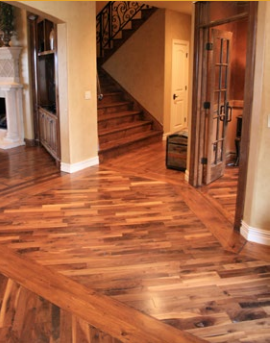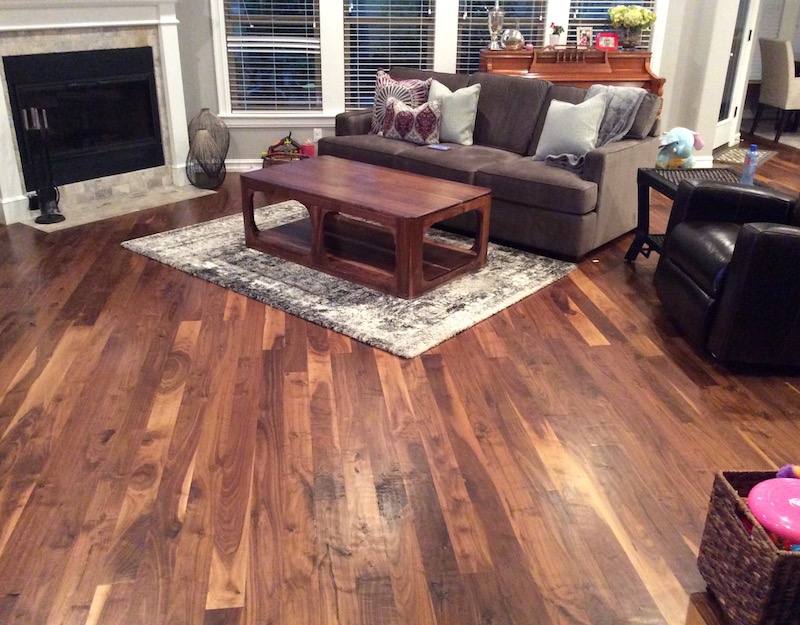Care and Maintenance
Learn more about how to care for your Renaissance Hardwood Floors
Introducing Renaissance
Congratulations on your purchase of genuine hardwood flooring from Renaissance Hardwood Floors. The Renaissance starts today. Nothing sets off a beautiful room and your interior designs like a Genuine Hardwood Floor. No other floor covering has the warmth and universal appeal that very simply says, quality.

Renaissance currently services more than 90 builders and architects from our showroom in Jenks. We staff 57 of the finest wood craftsmen and office support personnel in the business. Renaissance creates the highest quality custom-designed wood floors in Oklahoma. We utilize the most beautiful woods, install them to exact specifications, then finish to a brilliant luster by using the finest oil stains, waxes, and polyurethanes specifically manufactured for hardwood flooring. We stand behind our craftsmanship indefinitely and will not rest until you’re completely satisfied. To ensure you receive many years of service and beauty from your investment, we offer the following information on care, maintenance, and characteristics of your hardwood flooring purchase.
CARING FOR YOUR INVESTMENT
- Place mats at exterior doors to trap sand and grit from incoming traffic.
- Use area rugs on high-traffic pathways and wet areas.
- Use rugs that allow the wood to breathe. Avoid rubber or other nonventilated rugs or slip pads. Slight discoloration under the covered portion of the floor is normal and should be expected.
- Polyurethane coatings should last two to 10 years before recoating is required. The length of time between coats is directly related to the quality of care and the amount of traffic the floor receives.
- Install proper protectors on the feet of all furnishings subjected to movement. Felt is the best but should be checked periodically for wear and embedded grit. Protectors can be found at most home improvement and hardware stores. Vacuum, sweep, or dust mop regularly. Grit, dirt, and fine gravel will scratch the finish if left unattended.
- The use of wax, oil soap, or other household cleaners containing wax is not recommended. These products can dull the finish and make future recoating difficult, if not impossible.
- Avoid walking on your floors in high heels whenever possible. They can severely damage the surface of the flooring.
- Wood and water don’t mix. Never intentionally put water on any wood floor. On occasion, a damp mop is fine for polyurethane finishes. Excessive mopping, however, results in water seeping through the cracks, causing them to warp or cup. A waxed floor should never be cleaned with water. Even a damp mop can cause the spotting of wax finishes.
- Vacuum or dust mop weekly, more often at entrance doors, kitchens, and heavy traffic areas. A canister-type vacuum with a soft bristle brush is best. Central vacs with a similar brush are equally effective. We recommend Bona cleaning products. This cleaner is specifically made for polyurethaned floors with no harmful effect on the finish. We DO NOT recommend Bona Refreshers. They typically leave an uneven “mop and glow” appearance. Removing this product can be very costly. A waxed floor must be rewaxed once or twice a year using a liquid or paste wax, followed by buffing.
All finishes will over time show light scratches(polyurethane) or scuffs(wax) from normal everyday traffic, even with the best of care. This is normal and should be expected. A light buffing followed by a fresh coat of finish will restore polyurethane floors to a like-new appearance. A fresh coat of wax, followed by a thorough buffing, will bring new life back to a waxed finish.
Five Commonly Asked Questions
Why Is My Floor Warping?
Warping should not be confused with cupping. Warping is caused by excessive water coming in contact with the hardwood, usually caused by some type of water leak. More times than not, when we receive a call for warping, it is actually cupping. Cupping occurs when the wood flooring gains moisture on one side of the wood faster than the other, usually from high humidity.
With normal cupping, the edges will be raised higher on the edges than in the center. In high humidity regions, such as ours, slight cupping is normal, especially in planks over 3” wide. It is most noticeable while the house is unoccupied, without furnishings or drapes. Generally, as humidity decreases with the season, the cupping will correct itself.
The addition of heat during the colder months also will help. After the floors have cycled through the seasons, they acclimate to the environment specific to YOUR home, and become much more stable. The addition of de-humidifiers and humidifiers to your HVAC units is very beneficial in establishing consistent, year-round humidity levels inside your home. Severe cupping, like warping, can only be corrected by re-sanding. Since humidity is an unknown beyond our control, cupping is not covered under our warranty.
Why Is My Floor Squeaking?
The dry air, coupled with the dry heat produced by your home heating unit, pulls moisture from the wood, causing it to shrink and contract. The cracks that appear on your floor are caused by these conditions. Along with the cracks, you may detect some squeaks and slight movement of the floor when you walk, or place some weight on it. This is caused by the tongue shrinking slightly in the groove, causing looseness, allowing the wood to rub together and resulting in squeaks along with a slight up-and-down movement of individual planks. This is normal and will correct itself by mid-summer.
After your floor has gone through a dry season and a wet season, it will stabilize and acclimate to your new home’s environment. (Minor cracks and squeaks during the fall and winter are considered normal, even after acclimation). Each home’s environment is different, and the acclimation period will vary.

Why Does My Floor Have Cracks?
When a homeowner discovers cracks in their beautifully finished hardwood floors, naturally, they panic. All the wood in your home will contract and expand, according to the amount of moisture in the air. Oklahoma is located in the second wettest region in the United States, according to the National Oak Flooring Manufacturers Association. With rain and humidity, the moisture levels will increase in your wood floors, causing the wood planks to swell.
Conversely, in the extreme cold and dry months, they lose the excessive moisture, and shrink, leaving cracks. These cracks will most likely will appear in the fall, and remain throughout the winter. As humidity levels increase through the summer months, they again gain moisture, swell, and the cracks disappear. Wood will change continually until an equilibrium with the air is reached, and then becomes stable. Any cracks that remain 15 to 18 months after installation, can be filled to improve the appearance.

Why Do My Floors Look Dull?
This question usually comes up six to 12 months after the completion of a job. Homeowners often think they are incorrectly maintaining their floors. Generally speaking, this isn’t the case. The final coat of polyurethane finish is dry and can be walked on 12 hours (or less with waterborne finish) after application. However, they are not 100% cured. Your floor’s finish will continue to cure up to 30 days after they have dried. As the finish continues to cure, the sheen will slightly diminish. This is normal. Floors with a little more age lose some of their brightness simply because of traffic.
In addition to your regular cleanings, once or twice a year, deep clean. Vacuum or sweep the floors thoroughly, and clean TWICE with Bona cleaner, making sure to get plenty of cleaner along the seams. Follow this up by wiping down the floor with a hot, damp, terry cloth towel. (The hotter the towel, the quicker the water evaporates off the floor). Towel off the entire wood floor area. Thoroughly rinse the towel, and again, (with hot water), repeat the process. This deep cleans the cracks, crevices, and grain, and removes any film that may have built up over the year. For older floors, or floors with heavy traffic, it may be time to consider re-coating with a fresh coat of finish.
Can You Fix A Deep Scratch?
Scratches are considered deep if they break through the finish coat(s) enough to penetrate or crush the actual wood fibers. Scratches can be “typical”, caused by a sharp object such as a nail or knife, or they can be “crushing,” those caused by a heavy object being rolled across the surface. This type of damage can be deceiving because there is not an actual removal of the stain and finish, but rather a deviation or deflection of the grain, caused by the crushing of the wood fibers. Both can be repaired, usually by spot sanding the area involved and a small perimeter around the scratch. The location of the scratch, the direction of the wood, and the age of the stain are all factors in determining the amount of area around the actual scratch that will have to be included in the repair.
Renaissance Hardwood Floors Warranty
Our Warranty Provides:
- 1 year finish warranty (from date of final coat)
- 2 year material and workmanship warranty (from date of installation)
Our Warranty Does Not Cover:
- Acts of God
- Self-destruction
- Damage to floors due to malfunctioning appliances caused either by mechanical failures or human error.
- Ground water evaporation in crawl space applications
- Temporary housing expenses during repairs
- Removing and resetting furniture and fixtures
- Cupping and warping due to excessive weather-related humidity or high levels of humidity created by humidifiers
- Finish peeling caused by taping of any kind directly to the finish (Renaissance never recommends taping directly to floor regardless of the type of tape)
